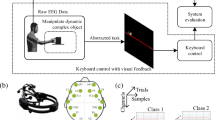Abstract
The classification of action intention understanding based on EEG signals is very important for human-robot and social interaction studies. In order to classify the action intention understanding brain signals efficiently, we first use three kinds of phase synchronization indices, phase locking value (PLV), phase lag index (PLI) and weight phase lag index (WPLI), to construct functional connectivity matrices in multiple micro time windows, and then extract the sum of significant edge values of each time window matrix as the classification feature, finally apply support vector machine (SVM) classifier to implement action intention understanding data classification task. Classification result shows that new method performs well on three datasets (alpha, beta and fusion frequency bands), and brain network statistical analysis demonstrates that many significant edges appear on the alpha frequency band. We conclude that the phase synchronization indices are extremely useful for the classification task, the sum of significant edge values is an effective classification feature, and the action intention understanding closely correlates with the alpha frequency band.
Access this chapter
Tax calculation will be finalised at checkout
Purchases are for personal use only
Similar content being viewed by others
References
Zhang, Z., Yang, Q., Leng, Y., Yang, Y., Ge, S.: Classification of intention understanding using EEG-NIRS bimodal system. In: 12th International Computer Conference on Wavelet Active Media Technology & Information Processing, Chengdu, pp. 67–70. IEEE (2015)
Brune, C., Woodward, A.L.: Social cognition and social responsiveness in 10-month-old infants. J. Cogn. Dev. 8(2), 133–158 (2007)
Catmur, C.: Understanding intentions from actions: direct perception, inference, and the roles of mirror and mentalizing systems. Conscious. Cogn. 36, 426–433 (2015)
Avanzini, P., Fabbridestro, M., Volta, R.D., et al.: The dynamics of sensorimotor cortical oscillations during the observation of hand movements: an EEG study. PLoS ONE 7, e37534 (2012)
Zhang, L., Gan, J.Q., Zheng, W., Wang, H.: Spatiotemporal phase synchronization in adaptive reconfiguration from action observation network to mentalizing network for understanding other’s action intention. Brain Topogr. 31(3), 447–467 (2017). https://doi.org/10.1007/s10548-017-0614-7
Ge, S., Ding, M., Zhang, Z., et al.: Temporal-spatial features of intention understanding based on EEG-fNIRS bimodal measurement. IEEE Access 5, 14245–14258 (2017)
Dindo, H., Lopresti, L., Lacascia, M., Chella, A., Dedić, R.: Hankelet-based action classification for motor intention recognition. Rob. Auton. Syst. 94, 120–133 (2017)
Bundy, D.T., Pahwa, M., Szrama, N., et al.: Decoding three-dimensional reaching movements using electrocorticographic signals in humans. J. Neural Eng. 13(2), 026021.1–026021.18 (2016)
Liu, H., Zheng, W., Sun, G., et al.: Action understanding based on a combination of one-versus-rest and one-versus-one multi-classification methods. In: 10th International Congress on Image & Signal Processing, Shanghai, pp. 1–5. IEEE (2017)
Niso, G., et al.: HERMES: towards an integrated toolbox to characterize functional and effective brain connectivity. Neuroinformatics 11(4), 405–434 (2013). https://doi.org/10.1007/s12021-013-9186-1
Lachaux, J.P., Rodriguez, E., Martinerie, J., et al.: Measuring phase synchrony in brain signals. Hum. Brain Mapp. 8, 194–208 (1999)
Stam, C.J., Nolte, G., Daffertshofer, A.: Phase lag index: assessment of functional connectivity from multichannel EEG and MEG with diminished bias from common sources. Hum. Brain Mapp. 28(11), 1178–1193 (2007)
Vinck, M., Oostenveld, R., Wingerden, M.V., Battaglia, F., Pennartz, C.M.A.: An improved index of phase-synchronization for electrophysiological data in the presence of volume-conduction, noise and sample-size bias. Neuroimage 55(4), 1548–1565 (2011)
Hari, R.: Action-perception connection and the cortical mu rhythm. Prog. Brain Res. 159(1), 253–260 (2006)
Avanzini, P., Fabbri-Destro, M., Volta, R.D., et al.: The dynamics of sensorimotor cortical oscillations during the observation of hand movements: an EEG Study. PLoS ONE 7(5), e37534 (2012)
Xiong, X., Yu, Z., Ma, T., et al.: Weighted brain network metrics for decoding action intention understanding based on EEG. Front. Hum. Neurosci. 14, 232 (2020)
Ortigue, S., Sinigaglia, C., Rizzolatti, G., Grafton, S.T.: Understanding actions of others: the electrodynamics of the left and right hemispheres. A high-density EEG neuroimaging study. PLoS ONE 5(8), e12160 (2010)
Arnaud, D., Scott, M.: EEGLAB: an open source toolbox for analysis of single-trial EEG dynamics including independent component analysis. J. Neurosci. Methods 134(1), 9–21 (2004)
Fogassi, L., Ferrari, P.F., Gesierich, B., et al.: Parietal lobe: from action organization to intention understanding. Science 308(5722), 662–667 (2005)
Acknowledgement
This work was supported in part by the National Nature Science Foundation of China under Grant 61773114, the Foundation of Hygiene and Health of Jiangsu Province under Grant H2018042, and the Key Research and Development Plan (Industry Foresight and Common Key Technology) of Jiangsu Province under Grant BE2017007-3.
Author information
Authors and Affiliations
Corresponding author
Editor information
Editors and Affiliations
Rights and permissions
Copyright information
© 2020 Springer Nature Switzerland AG
About this paper
Cite this paper
Xiong, X., Lu, X., Gu, L., Han, H., Hong, Z., Wang, H. (2020). Phase Synchronization Indices for Classification of Action Intention Understanding Based on EEG Signals. In: Yang, H., Pasupa, K., Leung, A.CS., Kwok, J.T., Chan, J.H., King, I. (eds) Neural Information Processing. ICONIP 2020. Lecture Notes in Computer Science(), vol 12534. Springer, Cham. https://doi.org/10.1007/978-3-030-63836-8_10
Download citation
DOI: https://doi.org/10.1007/978-3-030-63836-8_10
Published:
Publisher Name: Springer, Cham
Print ISBN: 978-3-030-63835-1
Online ISBN: 978-3-030-63836-8
eBook Packages: Computer ScienceComputer Science (R0)




